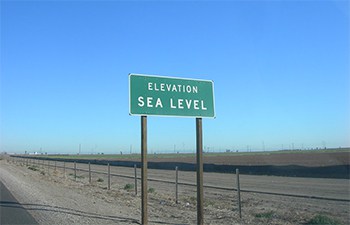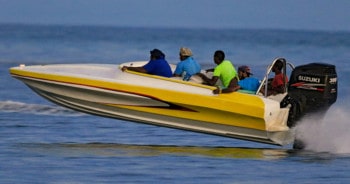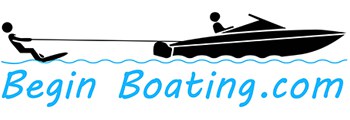Will your boat run at a higher speed when it’s in saltwater versus freshwater? There are many contributing factors that have to match up exactly in order to determine if this could be true or not.
A boat will run a couple miles per hour faster in saltwater versus freshwater when all contributing factors are the same, such as:
- Altitude
- Temperature
- Air Density
- Water Surface
- Weight Of Boat
- Buoyancy
Creating the exact same conditions is near impossible, but tests have shown that the better buoyancy aids in a slightly elevated speed.
This is actually a very debated topic, so the answers come from actual test runs keeping all contributing factors as close to the same as possible. Though as it turns out, the difference is quite insignificant. If you want to go faster, you will need to alter your boat.
Going Faster At Sea Level
 One of the contributing factors on a boat’s ability to produce a higher speed, is altitude. A combustion engine will run best at sea level, if all other conditions are equal. Obviously, if the engine is producing slightly more power, the boat will go faster.
One of the contributing factors on a boat’s ability to produce a higher speed, is altitude. A combustion engine will run best at sea level, if all other conditions are equal. Obviously, if the engine is producing slightly more power, the boat will go faster.
Not many freshwater bodies of water are at sea level, so the comparison has to take that into account and boat on the lowest elevation lake as possible for the test. Temperature and humidity play a factor for the engine as well as the water temperature.
Water temperature comes into play not just for the engine but also for buoyancy. Increasing water temperature causes water molecules to spread further apart, in turn reducing up-thrust, and allowing a floating object to displace more water as its buoyancy is reduced.
While temperature as a factor for buoyancy is quite minimal at best, saltwater having a higher buoyancy than freshwater is likely the biggest contributing factor of all the factors.
Saltwater And Buoyancy Provides Less Drag
A boat floating in saltwater is going to sit higher out of the water than it will in freshwater if the boat is kept at the same weight in both bodies of water. Saltwater is more dense and thereby allows the boat to displace less water.
 From the standpoint of the boat’s hull, since there is lees of the hull contacting the saltwater creating drag, the boat is allowed a slightly higher rate of speed. But, what about the propeller rotating in more dense water?
From the standpoint of the boat’s hull, since there is lees of the hull contacting the saltwater creating drag, the boat is allowed a slightly higher rate of speed. But, what about the propeller rotating in more dense water?
Here is where saltwater produces more drag on a boat in saltwater versus freshwater. While the prop will turn at a slower RPM (Revolutions Per Minute) in saltwater at WOT (Wide Open Throttle) because of the water density, that same water density allows for more thrust being created from the propeller.
So the effect on the propeller being in saltwater balances out to not be a contributing factor.
Make Your Boat Faster
There are a few simple things you can do to squeak a few more miles per hour out of your boat. First and most obvious is to reduce weight. Clearly a lighter boat is going to sit higher in the water and create less drag.
The second idea is to re-prop your boat. Choose a prop that is pitched at the upper end of the manufactures specs. You may not get on plane as quickly, but your top speed will increase. This brings us to the third way of increasing speed.
Knowing how to properly trim your boat’s drive will not only increase speed, but will also increase efficiency. As you gain experience, you will hear the boat’s engine and know where the correct trim adjustment is.
 Don’t trust your boat’s speedometer for showing your actual speed. You will want to use a GPS to tell you how fast you are moving. Next time you have you boat out on the water, test the accuracy of your boat’s speedometer against your phones GPS. You should do this at different levels of speed to really know what the boat’s gauge is telling you.
Don’t trust your boat’s speedometer for showing your actual speed. You will want to use a GPS to tell you how fast you are moving. Next time you have you boat out on the water, test the accuracy of your boat’s speedometer against your phones GPS. You should do this at different levels of speed to really know what the boat’s gauge is telling you.
Adjusting your boat’s trim properly will provide more speed also. With the boat trimmed all the way down, get to your fastest speed on the GPS. Then bump the trim up in small increments. In between adjustments, notice your speed. Continue to make small adjustments until your speed starts to drop. You should also notice the sound of the engine related to your speed results.
An additional option for people with outboard motors, is the use of a “jack plate”. The addition of an engine setback/jack plate, either manually or electro-hydraulically adjustable can make changes on the fly to compensate for changing water and load conditions. A jack plate should be considered a must-have for most outboard performance buffs.
How Much Difference Will Performance Changes Make
Re-Prop
 Making a change over to a performance stainless steel prop can gain you 2 to 5 miles per hour on your boat. As far as changing out parts to gain performance, this may be the lowest cost per MPH.
Making a change over to a performance stainless steel prop can gain you 2 to 5 miles per hour on your boat. As far as changing out parts to gain performance, this may be the lowest cost per MPH.
Stainless steel is much stronger than aluminum so there is virtually no flexing with a stainless prop. Not only that, but the blades of the stainless steel prop are going to be much thinner because of the strength of the steel, thus being able to slice through the water with much less resistance.
So with the simplicity and relatively low cost of removing an aluminum prop and installing a stainless steel prop, you will have your most economical speed increase on your boat.
ECM Re-flash
Having your ECM re-flashed may only gain you a couple mile per hour in your boat, but it is not a pricey performance upgrade either. So if you did a re-prop and a re-flash together, they would boost your speed by approximately 5 to 7 MPH.
Fuel injected boats have an ECM that controls the fuel and airflow as well as the engine timing and spark curve. Basically, the ECM is the engines brain. Just like going to a psychiatrist, making an adjustment to the way the brain tells the body/engine to operate, gains a positive result.
Blueprinting The Boats Hull
Blueprinting a boat’s hull simply means that the hull gets restored back to original specifications, along with a few tweaks that correct certain dynamics of the boat. Over time a boat’s hull can deform. This could be caused by many different things. It could be anything from a defect in the manufactures mold to storing the boat on a trailer that is not adjusted properly or just too short.
While this isn’t cheap, you may gain up to a 5 MPH increase.
You could also have your outdrives blueprinted as well. I could see going to this extent if you have a performance boat and are trying to eek out every MPH you can, but for recreational boaters, this doesn’t make much sense. Blueprinting both could realize a MPH gain around 10 MPH.
Bolt On Horsepower
 If you have deep pockets and need a place to get rid of some coin, you could always opt for a supercharger. You could buy a supercharger kit from a company like Procharger. They claim gains up to 50%!
If you have deep pockets and need a place to get rid of some coin, you could always opt for a supercharger. You could buy a supercharger kit from a company like Procharger. They claim gains up to 50%!
With this type of performance upgrade, you are most likely going to lose some reliability. But if speed is what you are focused on, then this is where you will probably get your largest gains.
If you are taking a 300HP boat engine and creating 450HP out of it, you are going to see some BIG gains in your speedo (I’m taking about your speedometer, not your swimsuit. Well, that depends on how much you like going fast in your boat. lol)
A supercharger basically compresses the air/fuel mixture before is enters the cylinder. More fuel and air in the combustion chamber makes for a lot more horsepower. With this big of a HP gain, you will want to consider the gearing and prop choice on your outdrive/s. It’s only money 🙂
Making A Boat Go Faster = Upgrades
So when it comes down to wanting your boat to go faster, it is a very small difference between saltwater and freshwater. If you want to go faster in a boat, you will have to make performance upgrades, or buy a different boat.
It goes without saying, that if you go faster, your boating skills need to increase. So do some research on boating at high rates of speed and be sure you know what you are getting yourself into.

